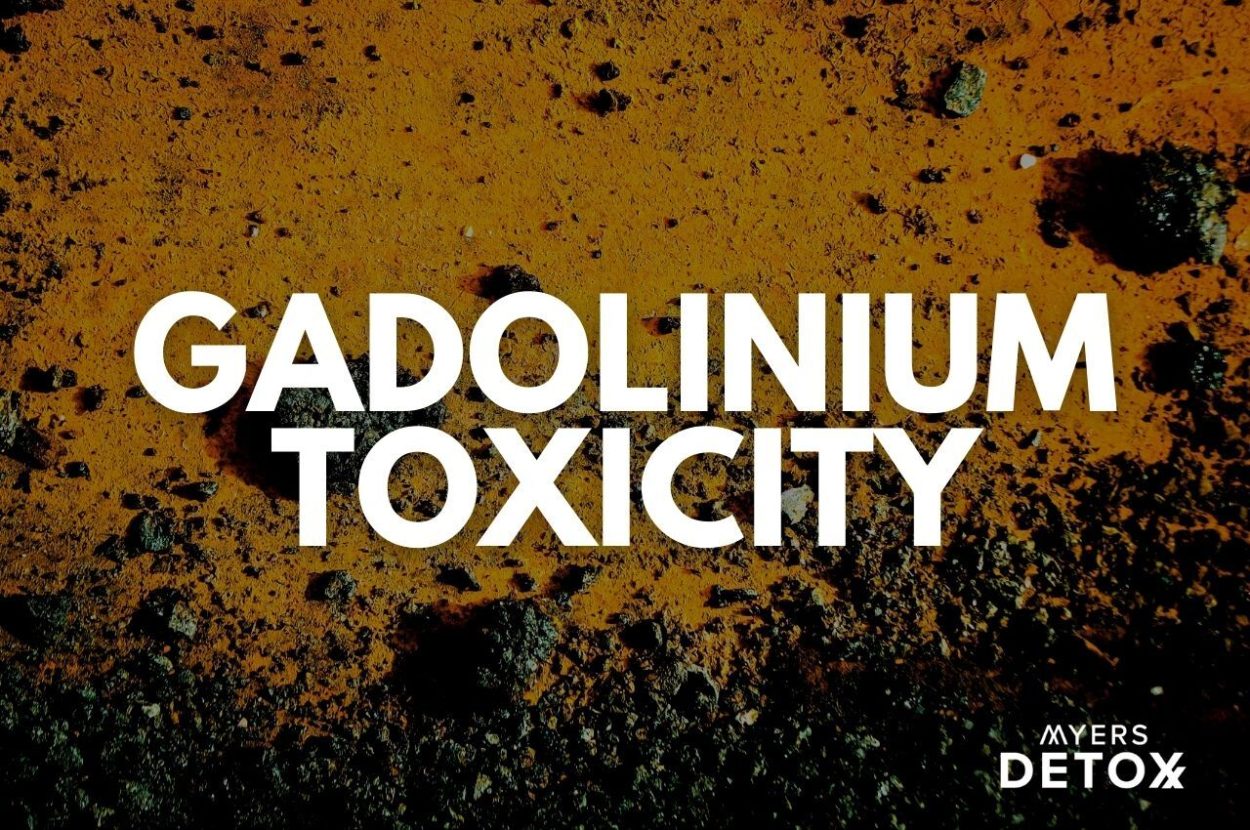Gadolinium is a compound frequently given as a contrast agent prior to MRI’s and CT scans. While for years it was seen as a harmless contrasting agent, research is beginning to show the devastating effects that this heavy metal can have on your body.
This article will serve to shed light on the effects of retained Gadolinium from Gadolinium-Based Contrast Agents (GBCAs) used for MRIs, CT scans, and MRAs.
To make matters worse, gadolinium toxicity doesn’t just affect those that are undergoing MRI’s. Once excreted through the urine, gadolinium enters the water supply and can end up in your drinking water.
That means that you and your family could be unknowingly exposing yourselves to this toxic compound on a daily basis.
A very public example of the devastating effects of gadolinium toxicity comes from Chuck Norris’ wife, Gena Norris. After receiving an MRI, Gena began experiencing a long list of health issues along with chronic fatigue — all of which she contributed to gadolinium toxicity. As a result, she has bravely spoken out publicly about banning the use of gadolinium as a contrast agent in medical scans.
Like most people undergoing an MRI, Gena had full faith that the healthcare system was taking care of her, not putting her at further risk for health challenges. This is just one more example of how crucial it is that we self advocate for our own health and that of our families.
In this article, you’ll learn:
- What is gadolinium?
- Sources of gadolinium toxicity
- Who is most at risk for gadolinium toxicity?
- Signs and symptoms of gadolinium toxicity
- Health conditions caused by gadolinium
What Is Gadolinium?
Often used as a contrasting agent for MRIs (magnetic resonance imaging) and CT scans, gadolinium helps doctors diagnose abnormalities in your body[35].
The medical community is acutely aware of the toxic effects of gadolinium, which is why it is complexed with neutralizing compounds before being administered. However, research is showing that despite the effort to neutralize gadolinium, high levels of this heavy metal are still being found in bodily tissues months, and even years after MRI scans[1].
Sources of Gadolinium Exposure
The top sources of gadolinium include:
- Contrasting Agent For MRI’s
- Water
- Industry and manufacturing of electronics, magnets, and superconductors used for nuclear, microwave, and radar technology. Thus, it can get into air, soil and water.
Contrasting Agent For MRI’s
The most common source of gadolinium toxicity in the environment is due to its role as an MRI (mirror resonance imaging) and CAT scan contrast agent [2].
Contrast agents are used to improve the visibility of the internal structures of the body when using an MRI or CAT scan. Gadolinium is the most common compound used as an MRI contrast agent and is given either orally or intravenously.
While historically it was believed that gadolinium entered your body and was excreted completely intact, research has shown that this toxic compound can actually lodge into the healthy tissues of your body.
In fact, some research shows that this toxic metal can stick around in the body for over two years after the initial MRI[28]. Even longer, if you’re not able to excrete it.
What’s more, MRI’s themselves can mobilize gadolinium from past MRI’s. People have given reports that they do MRI’s without contrast agents and then experience a flare of their gadolinium symptoms like pain and losing their sense of taste afterwards.
Although gadolinium given for MRI scans is always accompanied by a neutralizing compound that is supposed to keep it from entering the tissues of your body, research shows that in some cases, this strategy fails and the gadolinium becomes toxic to the patient [3].
Most notably, gadolinium can be found in the brain, kidneys, thyroid, ovaries and bones of people who undergo MRIs. The effects can be wide-ranging and affect your skin and musculoskeletal and neurological systems [2].
So what’s the medical community doing about this potential danger?
The FDA (Food and Drug Administration) announced that it will require safety measures for certain contrast agents like gadolinium, recognizing that small amounts can be retained in the brain and other tissues. These safety measures include requiring a new warning label to alert healthcare professionals that gadolinium can remain in the body, including the brain, for months to years after an MRI[29]. But many times this information is not given to a patient or they are unaware of the dangers.
While this is a step in the right direction, other agencies like the EMA (European Medicines Agency) have suspended the use of three common agents that contain gadolinium and are known to cause toxicity. For all other gadolinium-containing agents, they recommend use of the lowest dosage possible, and only when absolutely necessary[30].
Contrasting Agents To Watch Out For:
The following linear agents are recommended for suspension by the Pharmacovigilance and Risk Assessment Committee (PRAC):
- Gadobenic acid, marketed as MultiHance by Bracco Diagnostics Inc.
- Gadodiamide, marketed as Omniscan by GE Healthcare
- Gadopentetic acid, marketed as Magnevist by Bayer HealthCare Pharmaceuticals
- Gadoversetamide, marketed as OptiMARK by Mallinckrodt Inc.
- Gadopentetic acid, marketed as Magnevist by Bayer HealthCare Pharmaceuticals
Gadolinium In Water
Another source of gadolinium in our environment comes from the water supply. After gadolinium is taken as a contrasting agent, it’s excreted through your kidneys in your urine. From here, you flush that water down the toilet and it ends up recirculating in the water supply.
In fact, research shows that groundwater is getting more and more polluted with gadolinium.
Typically chemical compounds would be filtered out of water before they reach your home faucet. In the case of gadolinium, however, treatment plants do not test for or filter for this heavy metal — leaving it free to enter your home’s water system.
The result? The water that you cook with, bathe with, and even drink may be contaminated with this heavy metal[31].
One could assume that someone would have to drink very large amounts of tap water containing gadolinium before it might cause them any harm. However, it is never wise to assume anything, especially when someone’s health could be adversely affected.
I believe that everyone should be concerned about the increasing amount of gadolinium that is in our water supplies in the U.S. and around the world. This is why it is so important to filter your water.
Of course, when it comes to water filtration in your home, you have many great options. I’ve come across and tried many different products, but I have to say that the Alkaline Hydrogen Water Filter from Ph Prescription stands out from all other water filters.
It caught my attention because the Alkaline Hydrogen Water Filter is the first filter I’ve seen that removes such a broad spectrum of pollutants and restores water’s natural pH, but also energizes the water and adds hydrogen to it. I was beyond impressed with this system!
Who Is Most At Risk For Gadolinium Toxicity?
Certain populations are more susceptible to gadolinium toxicity, for instance, those who require multiple MRI scans, pregnant women, children, and patients with kidney disease or inflammatory conditions[29].
I think that anyone that knows they are heavy metals toxic or have trouble detoxing should avoid gadolinium based MRIs because it’s likely they may also have trouble excreting the gadolinium.
Here’s a closer look at some of the biggest risk factors associated with gadolinium toxicity[32]:
Retention from MRIs
Simply having an MRI can put you at risk for gadolinium toxicity. It’s estimated that 1% of the gadolinium contained in each dose of the contrast agent is retained in your body and deposited in your bones. This becomes especially worrisome for people that have multiple MRIs.
Impaired Renal Function
Imapried renal function represents the largest risk factor for gadolinium toxicity. Your body relies primarily on your kidneys to clear gadolinium from your body. Therefore, altered kidney function can lead to increased retention of gadolinium which could ultimately result in toxicity.
Unstable Contrast Agents
There are certain contrast agents that are less stable than others. When you have a contrast agent that’s unstable it increases the risk of gadolinium becoming free and depositing in your body.
Altered Blood-Brain Barrier
Having a compromised blood-brain barrier is another risk factor for gadolinium retention. When your blood brain barrier is not intact it can result in gadolinium being deposited in your brain tissue, regardless of how strong your renal function is.
Transmetallation
Transmetallation occurs when other ions in your body such as zinc, calcium, copper, and iron displace gadolinium from its chelate, resulting in gadolinium staying in your body.
Extravasation
Extravasation happens when the contrast agent is injected improperly and ends up in your soft tissue instead of directly injecting into your vein. This can cause inflammation, edema, and necrosis of the tissue — along with retention of gadolinium in your body.
Acidosis
Acidosis is a condition in which your body is more acidic than it should be. When gadolinium is in an acidic environment the rate at which it can be released increases. Causes of acidosis include diabetes, high protein diets, chronic disease, excess alcohol or coffee consumption, liver failure, low blood sugar, and poor digestion.
Genetics
The retention of gadolinium can be due to genetic variations, but the underlying issue is always an inability to properly detox this heavy metal out of the body. If your liver isn’t functioning properly, or your detox pathways are blocked, you won’t be able to adequately remove gadolinium.
Unfortunately, due to the high levels of toxicity in our environment these days, many people have poorly functioning livers and detoxification systems and don’t even realize it.
Symptoms of Toxic Exposure From Gadolinium
Symptoms of toxicity can start within the first few hours of being exposed. However, for some it can take weeks or even months for symptoms to appear. The symptoms can range from intense to subtle and can be emotional, mental, and physical.
Due to the intense nature of the symptoms associated with gadolinium toxicity, there are even support groups that help people cope with these unpleasant and often frightening side effects. You can find many support groups on Facebook.
While symptoms do tend to fade with time, many people report lingering issues that have lasted five years or long — with permanent disability[4].
After ingesting gadolinium, many people experience side effects including[4][5][2]:
- Headache
- Brain fog
- Dizziness
- Bone and nerve pain
- Nausea
- Changes in taste
- Pins and needles (tingly and burning sensations)
- Skin thickening
- Muscle twitching
- Vomiting
- Tight skin
- Lesions
- Hair loss
- Itchy skin
- Balance problems
- Swelling (edema)
- Fatigue
It should be noted that while some of these side effects are short-lived, brain fog and headaches have been shown to last for up to three months in some people. And some have symptoms for years.
Health Conditions Caused by Gadolinium
Gadolinium toxicity occurs after treatment with gadolinium and can present with a wide range of symptoms.
The real issue with using gadolinium as an MRI contrast and CT scan agent is that it can build up in your body — a condition termed gadolinium retention. When your body holds on to this toxic metal, it builds up in your bones, brain, kidney tissue, and more.
Gadolinium can, therefore, remain in your body for months or even years[4].
Due to gadoliniums affinity for the tissues in your body, toxicity can eventually result in three very serious conditions — nephrogenic systemic fibrosis, gadolinium deposition disorder, and Morgellons disease.
Nephrogenic Systemic Fibrosis (NSF)
NSF is a progressive disease caused by gadolinium toxicity in your body that leads to the hardening and thickening of your skin and internal organs.
In general, NSF is a condition that primarily affects people with kidney disease. However, this disease can be fatal– with 30% fatality reported. The exact mechanism for the disease is still unclear, but it raises real concern due to the fact that many people may have kidney insufficiency and may not be aware of it.
There currently aren’t any treatment protocols for this condition, although hemodialysis is one approach that some hospitals use.
Symptoms of NSF can present immediately after a dose, or up to 11 days later. Plaques on the skin that are red, itchy, inflamed, and hardened are typical signs of NSF. However, the real danger lies under the skin where the hardening of internal organs can occur[6].
Gadolinium Deposition Disorder (GDD)
If you’re thinking that you’re in the clear because you have healthy kidney function– think again. Gadolinium Deposition Disorder (GDD) is a similar condition to NSF, but it affects people with healthy kidneys[7].
In GDD, gadolinium can deposit in your tissues — with a particular concern for your brain tissue[8].
Morgellons Disease
Morgellons disease is one of the most common symptoms of gadolinium toxicity.
Primarily a skin disease, Morgellons disease is characterized by small fibers appearing in slow or non-healing sores. These skin lesions and fibers are often accompanied by stinging, pain, or crawling sensations under the skin.
People with Morgellons disease are in severe discomfort, feeling as though bugs are crawling under their skin night and day.
Alternatives to Gadolinium Contrast Agents
In terms of more natural contrasting agents, there are some potential options out there.
Barium contrast agents are an alternative, particularly for MRIs of the upper and lower gastrointestinal tract and other parts of the body that exhibit continuous movement. Barium does come with its fair share of side effects, including stomach cramps, diarrhea, nausea, vomiting, diarrhea, itching, agitation, confusion, swelling, and more. However, it’s still significantly less problematic than gadolinium[33][34].
There are many different types of imaging on the market today. While there are alternatives to gadolinium, you’d have to consult with your doctor on available contrast options.
How To Encourage the Natural Excretion of Pollutants Like Gadolinium
If you’ve had an MRI or CT scan, then taking measures to detox gadolinium is crucial. However, even if you haven’t had either of those procedures, you still may be exposed to gadolinium in your drinking water.
This is why a gadolinium detox shouldn’t just be an option or an afterthought; it should be a top priority.
Here are some of the most powerful supplements you can take for gadolinium detox:
Support For Your Body’s Natural Elimination of Environmental Pollutants
Unfortunately, heavy metals like gadolinium can be tricky to remove from the body since they lodge so deeply into your tissues. That’s why I formulated Citricleanse. Citricleanse is a powder that contains a combination of grapefruit pectin, cilantro extract, and a humic acid/fulvic acid blend. Together, these three ingredients assist your body’s natural detoxification processes in a way that specifically supports heavy metal clearance through mineralization, mobilization, and toxin binding.
Mineralization: Fulvic acid and humic acid are rich sources of a variety of minerals. When introduced to your body, they flood your system with minerals which assists your tissues in pushing out heavy metals that are trapped in your cells.
Mobilization: Cilantro extract works to mobilize metals that have been liberated from your cells, moving them away from your tissues and into channels for elimination.
Toxin Binding: Grapefruit pectin acts like a net that catches freed impurities that have been mobilized by the cilantro and fulvic/humic acids. Your body may then excrete these unwanted compounds via your organs of elimination.
Liver Support
Among your detoxification organs, your liver is by far the hardest working. That’s why regardless of what you’re trying to release from your body, liver support is always crucial. However, when choosing a liver support supplement, it’s vital that you ensure that the ingredients included are high quality.
I recommend that everyone keep a container of Daily Detox in their cupboard. This detox blend contains an array of research-based superfoods that support your liver’s natural detoxification pathways, gently enhancing the reduction of your toxic load.
Other Supportive Supplements and Tools:
EDTA Chelation
Kelatox is a suppository supplement containing EDTA, a synthetic amino acid that assists in your body’s natural process of removing environmental pollutants; specifically gadolinium. This can be an excellent addition to your detoxification protocol as it offers a unique route for supporting and encouraging metal detoxification naturally.
Zeolites
Zeolites can adsorb a variety of minerals – including unwanted metals. Once captured, these toxins are rendered useless in your body, which allows them to be readily eliminated. You can find a variety of zeolites supplements out there, but my favorite by far is Cytodetox due to its potency and quality.
Ionic Foot Baths
Ionic foot baths are an excellent tool for assisting with your detox efforts. Using ions, which are naturally present in nature, an ionic foot bath assists your cells and tissues in releasing unwanted compounds and drawing them out of your body through your feet. I recommend the AMD Ion Cleanse Foot Bath.
Takeaways
Like all heavy metals, it’s vital to consider the cumulative effects of ingesting gadolinium. While procedures like MRIs and CT scans can introduce a large amount of gadolinium to your body at once, other sources of gadolinium can slowly build up in your system by absorption in the GI tract and cause serious health concerns related to long-term exposure.
Gadolinium lodges in your tissues, with a particular affinity for your kidneys and brain. Symptoms, therefore, can be emotional, physical, or mental. Dizziness, muscle twitching, pins and needles, headaches, vomiting, hair loss, and fatigue are just a handful of the common side effects of gadolinium toxicity.
Left untreated, toxic levels of this metal can induce Morgellons Disease, Gadolinium Deposition Disorder (GDD), and Nephrogenic Systemic Fibrosis (NSF). For many people, these conditions become debilitating.
Consistently supporting your body’s detoxification efforts is vital at this point in time. Heavy metals are everywhere in our environment, even in places where you would least expect them (like contrasting agents).









